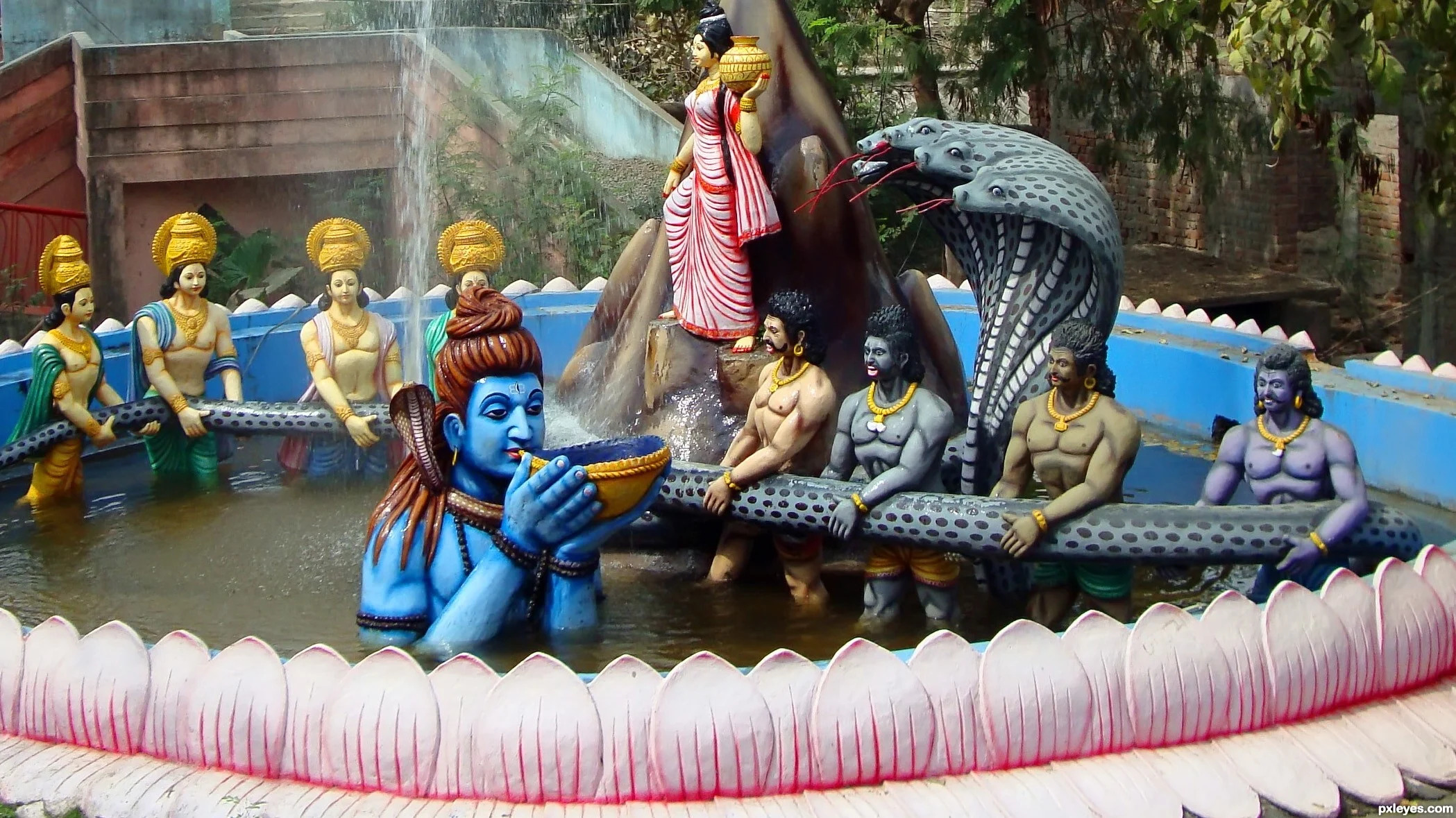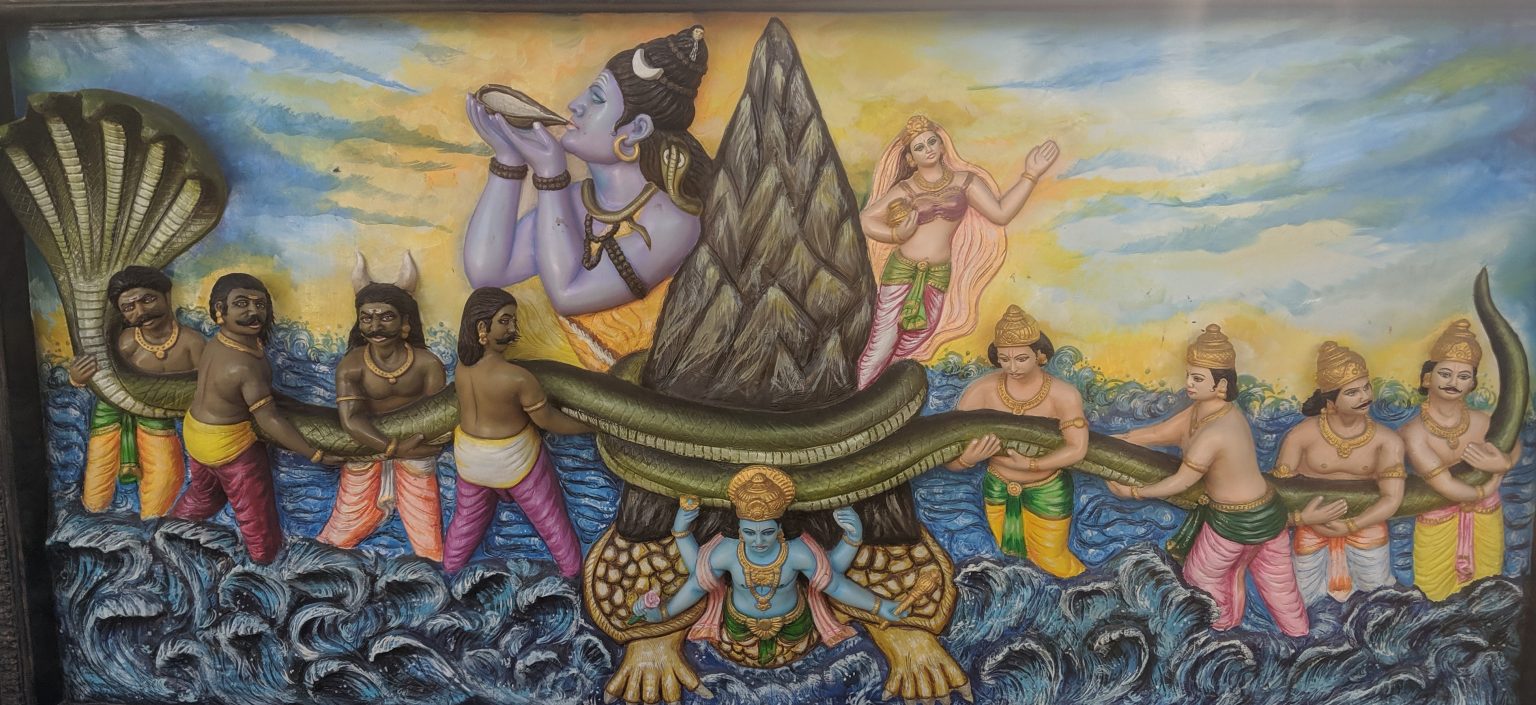
Mandar Hill or the Mandar Parvat is the very same Mandarachala Parvata from the Samudra Manthana episode of Vedic Age. It is currently present in Bihar. This sacred hill is also connected to the killing of Madhu and Kaitabha demons by Lord Vishnu.
Everyone born in the sacred land of Bharat knows about the Samudra Manthana and the Mandar Hill. It is a great episode of Vedic History in which many incarnations of Lord Vishnu took place including the Kurma Avatara and Mohini Avatara.
The significance of Mandar Hill
The Mandar Hill is mentioned in Vishnu Purana and the Skanda Purana. The Vishnu Purana specifically points to the location of this hill. In this regard it states:
mandaram shikharam drishtva, drishtva wa madhusudana |
kamadhenu mukham drishtva, punar janma na vidyate ||
chir chandanya madhye mandaro nama parvate, tasya rohana maatrena naro naarayana bhavet ||
At least 2200 years ago, there was a beautiful city located near the Mandar Hill. The city itself had 88 holy kundas, 53 roads and 52 markets. The city was known as the Balish Nagar which is now known as Baunsi. From far, the 700 feet tall hill appears just like a vertical churning rod.
As per Chaitanya Bhagavata and Chaitanya Charitamrita, Chaitanya Mahaprabhu, the kali-yuga avatara of Lord Krishna visited Mandar Hill enroute Gaya Dham. He had visited all the temples atop the hill and had darshan of Lord Madhusudana. Bhaktisiddhanta Saraswati Thakura had installed Sri Chaitanya Pada atop the hill.
It is said that when Lord Vamana was claiming the Earth, He kept His lotus feet on top of this Parvata.
Samudra Manthana and the marks of Vasuki
Saumdra Manthana is described in all the Vedic Literatures such as Bhagavata Purana, Mahabharata, Ramayana, Vedas, Upanishads, and other Puranas. We shall refer to the one mentioned in the Bhagavata Purana. During the time of Sixth Manu known as Chakshusha, Indra was cursed by Durvasa Muni to be poverty stricken. At the same time, Indra was attacked by the demons and got defeated.
To get relieved from their pitiable condition, all the devatas approached Lord Brahma on the top of Mountain Sumeru, who advised them to take shelter of Lord Vishnu. After reaching Shvetadvipa, Lord Brahma offered prayers in glorification of Lord Vishnu, pleased by which Lord Narayanan gave them darshan.
Lord Vishnu advised the devatas to make truce with the demons and to churn the ocean of milk to produce nectar out of it. Indra then approached Maharaja Bali, the king of demons and convinced him of the proposal of Lord Vishnu.
Soon, the devatas and demons uprooted the great Mandara Parvata to use it as a churning rod for churning the ocean of milk. Because the mountain was made of gold, it was very heavy, making devatas and demons unable to carry it. On the way, it fell from their hands and crushed many demons and demigods to death.
Looking at the frustrated and tiring attempts of devatas and demons, Lord Narayana appeared there; He glanced at the dead and wounded bodies of the devatas and demons and rejuvenated them. The dead ones came back to life. Lord Vishnu then lifted the mountain with one hand and placed it on the back of Garuda.
Thereafter Lord Vishnu asked Garuda to unload the mountain on the ocean and asked him to leave as Vasuki had to be used as the churning rope. Soon the churning began with devatas holding the tail of Vasuki and the demons holding the mouth of Vasuki. As the mountain was heavy and it did not have any support from below, it sank to the bottom of the ocean.
Looking at the situation, Lord Vishnu assumed the form of a tortoise, entered the ocean, and lifted the great Mandarachala Parvata to the surface. Not feeling the slightest weight of the mountain, Lord Vishnu felt the churning of the mountain just like scratching and felt pleasant. He took another form with thousands of hands and held the mountain from top with one hand.
The ocean first produced Halahala poison which was drank by Lord Shiva. Then, the Surabhi cow, Ucchaishrava horse, Airavata, the king of elephants and so on. Finally, the most awaited nectar appeared from the ocean of milk which was held by Lord Dhanavantri.
Not able to resist themselves, the demons snatched away the pot from the hands of Dhanavantri and ran away without considering the share for the devatas. Lord Vishnu made them fight each other for drinking the nectar first. While this was ensuing, Lord Vishnu took the form of a very enchanting woman known as Mohini Murti and took the possession of the nectar pot. She distributed the nectar to devatas and killed Rahu.
After the churning of the ocean of milk, the Mandar Hill was kept in its current location. Even today the marks of Vasuki’s scales can be observed in the hill.
The temples at Mandar Hill
The Mandar Hill has got religious significance in the Sanatana Dharma, Buddhism and Jainism. All of them hold this hill sacred. Atop the hill are the Jain Temples and the Vishnu temples are on the foothill of Mandar Hill. There are many ancient sculptures and inscriptions spread all over the hill. There were around 26 temples on the hill. All were broken by Kala Pahar, the chief commander of Daud Khan.
Madhusudana Temple, Baunsi
This is the predominating temple of this area. Lord Madhusudana is the Deity of Mandar Hill. This is an extremely enchanting form of Lord Vishnu. Earlier this temple was situated atop the hill. The temple was broken by the Adharmis but the Deity was safeguarded and kept here for worshipping.
Papaharni Sarovara
Earlier known as Manohara Kunda, this sarovar was renovated by Queen Kona Devi who also did the prana pratisthapana of Lord Narasimha here. This is situated on the foothill of Mandar Hill. The climb to the peak of Mandar Hill begins from here. According to the inscriptions, the Chola King was rid of the skin disease after taking bath at this kunda. In the middle of the Kunda is a beautiful Vishnu Temple. Even today, one can also have darshan of Lord Narasimha.
Madhusudana Mukha
Near Sita Kunda, there is a face of Lord Madhusudana carved within the rock of the hill. This face is around 15 feet tall. After killing the rakshasa Madhu, his severed head would still torment the brahmanas and the devatas. Hence, Lord Vishnu buried his head under the Mandar hill. And sat on top of it. Since then, Lord Madhusudana eternally lives here.
There are other temples like the Kamadhenu Cow and the residence of Chola King in this place. Atop the hill, one can also have darshan of Lord Narayana’s lotus footprint.
Best time to visit Mandar Hill
September to March is the best time to visit Mandar Hill due to the ideal weather. During Makara Sankranti, Mandar Madhusudana Mela takes place during which thousands of devotees throng the sacred hill to take bath in the Papaharni Sarovara and have darshan of Lord Madhusudana. Mahavir Jayanti is also crowded.
How to reach Mandar Hill
Mandar Hill is situated in Baunsi District of the Bhagalpur Division of Bihar. To reach Mandar Hill without any difficulty and anxiety, it is better to join the Ayodhya Kashi Yatra of Tirtha Yatra. All the arrangements shall be taken care of. You can just focus on having darshan of Mandar Hill.
If you really enjoy exploring and traveling solo, here are the means to reach Mandar Hill
By Air – Deogarh is the nearest domestic airport. From Deogarh, you may either travel by rail or the roadways. Deogarh has got limited connectivity. Next best option is to travel to Patna Airport and then reach Baunsi.
By Rail – Mandar Hill is the nearest railway station. From here state transport vehicles ply regularly to Mandar Hill and return. You may also take up private autos and taxis.
By Roadways – Reaching Baunsi by roadways is quite easy. From Patna, Bhagalpur and Deogarh state road transport buses are available till Baunsi. From there, you can take up private transport to reach Mandar Hill.
0












Leave a Reply